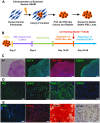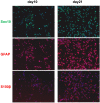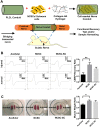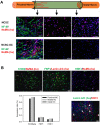The Differentiation Stage of Transplanted Stem Cells Modulates Nerve Regeneration
- PMID: 29234013
- PMCID: PMC5727226
- DOI: 10.1038/s41598-017-17043-4
The Differentiation Stage of Transplanted Stem Cells Modulates Nerve Regeneration
Abstract
In regenerative medicine applications, the differentiation stage of implanted stem cells must be optimized to control cell fate and enhance therapeutic efficacy. We investigated the therapeutic potential of human induced pluripotent stem cell (iPSC)-derived cells at two differentiation stages on peripheral nerve regeneration. Neural crest stem cells (NCSCs) and Schwann cells (NCSC-SCs) derived from iPSCs were used to construct a tissue-engineered nerve conduit that was applied to bridge injured nerves in a rat sciatic nerve transection model. Upon nerve conduit implantation, the NCSC group showed significantly higher electrophysiological recovery at 1 month as well as better gastrocnemius muscle recovery at 5 months than the acellular group, but the NCSC-SC group didn't. Both transplanted NCSCs and NCSC-SCs interacted with newly-growing host axons, while NCSCs showed better survival rate and distribution. The transplanted NCSCs mainly differentiated into Schwann cells with no teratoma formation, and they secreted higher concentrations of brain-derived neurotrophic factor and nerve growth factor than NCSC-SCs. In conclusion, transplantation of iPSC-NCSCs accelerated functional nerve recovery with the involvement of stem cell differentiation and paracrine signaling. This study unravels the in vivo performance of stem cells during tissue regeneration, and provides a rationale of using appropriate stem cells for regenerative medicine.
Conflict of interest statement
The authors declare that they have no competing interests.
Figures





Similar articles
-
Induced pluripotent stem cells for neural tissue engineering.Biomaterials. 2011 Aug;32(22):5023-32. doi: 10.1016/j.biomaterials.2011.03.070. Epub 2011 Apr 22. Biomaterials. 2011. PMID: 21514663 Free PMC article.
-
Low-intensity pulsed ultrasound combination with induced pluripotent stem cells-derived neural crest stem cells and growth differentiation factor 5 promotes sciatic nerve regeneration and functional recovery.J Tissue Eng Regen Med. 2019 Apr;13(4):625-636. doi: 10.1002/term.2823. Epub 2019 Mar 19. J Tissue Eng Regen Med. 2019. PMID: 30770650
-
Optimal electrical stimulation boosts stem cell therapy in nerve regeneration.Biomaterials. 2018 Oct;181:347-359. doi: 10.1016/j.biomaterials.2018.07.015. Epub 2018 Jul 20. Biomaterials. 2018. PMID: 30098570 Free PMC article.
-
Pluripotent stem cells for Schwann cell engineering.Stem Cell Rev Rep. 2015 Apr;11(2):205-18. doi: 10.1007/s12015-014-9577-1. Stem Cell Rev Rep. 2015. PMID: 25433863 Review.
-
Perspective on Schwann Cells Derived from Induced Pluripotent Stem Cells in Peripheral Nerve Tissue Engineering.Cells. 2020 Nov 17;9(11):2497. doi: 10.3390/cells9112497. Cells. 2020. PMID: 33213068 Free PMC article. Review.
Cited by
-
Human-Induced Pluripotent Stem Cells in Plastic and Reconstructive Surgery.Int J Mol Sci. 2024 Feb 3;25(3):1863. doi: 10.3390/ijms25031863. Int J Mol Sci. 2024. PMID: 38339142 Free PMC article. Review.
-
Directly induced human Schwann cell precursors as a valuable source of Schwann cells.Stem Cell Res Ther. 2020 Jun 26;11(1):257. doi: 10.1186/s13287-020-01772-x. Stem Cell Res Ther. 2020. PMID: 32586386 Free PMC article.
-
Biomaterial-Based Schwann Cell Transplantation and Schwann Cell-Derived Biomaterials for Nerve Regeneration.Front Cell Neurosci. 2022 Jun 28;16:926222. doi: 10.3389/fncel.2022.926222. eCollection 2022. Front Cell Neurosci. 2022. PMID: 35836742 Free PMC article. Review.
-
Tissue Engineered Neurovascularization Strategies for Craniofacial Tissue Regeneration.ACS Appl Bio Mater. 2022 Jan 17;5(1):20-39. doi: 10.1021/acsabm.1c00979. Epub 2021 Nov 29. ACS Appl Bio Mater. 2022. PMID: 35014834 Free PMC article. Review.
-
Regeneration of sciatic nerves by transplanted microvesicles of human neural stem cells derived from embryonic stem cells.Cell Tissue Bank. 2020 Jun;21(2):233-248. doi: 10.1007/s10561-020-09816-5. Epub 2020 Feb 12. Cell Tissue Bank. 2020. PMID: 32052220
References
Publication types
MeSH terms
Substances
Grants and funding
LinkOut - more resources
Full Text Sources
Other Literature Sources

